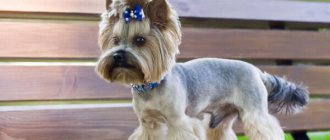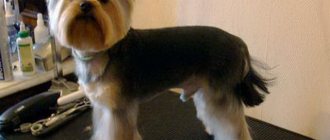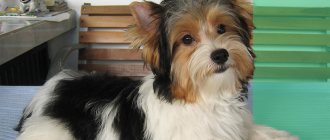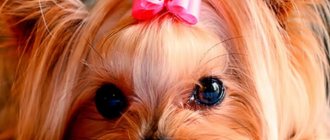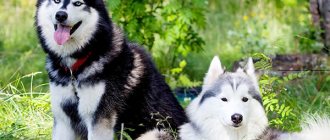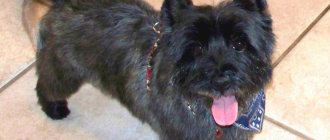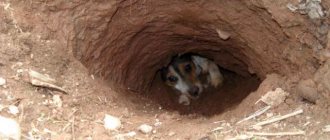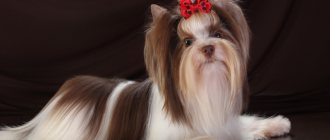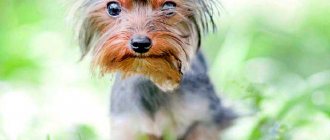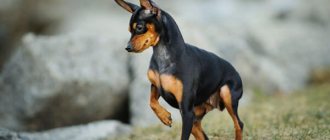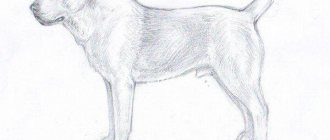The Yorkshire Terrier is one of the most popular and recognizable dog breeds in the world.
But not everyone knows that, in addition to the standard Yorkies, many more varieties of this breed have been bred, differing from each other in size and color.
And not all future owners of Yorkshire dogs with a standard color think about what a Yorkshire terrier puppy should look like and how its external differences from adult dogs are expressed.
What should a purebred Yorkie of any variety, gender or age look like?
Origin story
The Yorkie was not always a lap dog. At the dawn of the breed's history, these dogs, bred in Yorkshire, were working terriers: they destroyed rodents in houses and in mines.
Only later did they become a salon breed, and their popularization was greatly facilitated by the fact that Yorkshires were the favorites of Queen Victoria, during whose reign the breed was officially recognized.
At the beginning of the 20th century, the number of Yorkies was still small, but it was from this time that their spread throughout the world began..
The 1940s did not have the best effect on the breed, since during the Second World War people had no time for breeding dogs that had no practical value for the front.
But after its end, the number of Yorkies began to increase again, and the popularity of the breed began to revive.
By now, Yorkshire dogs are loved in many countries, including Russia . We can say that this is one of the most famous small dog breeds in the modern world.
Feedback from livestock farmers
Anton, 42 years old, Lebedyan
I would like to have several Yorkshire sows, but the price of breeding piglets is steep. Three years ago I bought a purebred boar and raised it. Now I take him with my pigs (Landrace-Duroc cross). I saw the result immediately: the offspring became noticeably larger and stronger, and the weight gain was higher. I'm going to keep the pigs from these crosses for repairs. I think the piglets should fatten well from them.
Nikolay, 55 years old, Leningrad region
One of my sows is Yorkshire. They warned that the breed is afraid of the cold, but there were no difficulties with my pig: the pigsty is well insulated. I've pigged twice already. The kids are beautiful, although they are crosses with Landrace. I will keep her “daughter” for offspring. I will try to buy a purebred boar to strengthen the Yorkshire “blood” in the offspring. An excellent breed: reliable, productive and not at all capricious.
Natalya, 39 years old, Samara
In my opinion, it is better to take these pigs for breeding first. I “splurged” on two purebred pigs and a boar at once, and didn’t regret it for a minute. Now it is possible to sell young animals and fatten a couple of babies from each farrow. I don’t keep piglets over 100 kg: I don’t like too fatty pork. But the bacon turns out amazing. I believe that the expenses for purebred producers have fully paid off for me.
Breed standard
According to the breed standard, the height of a standard Yorkie should not exceed 22 cm at the withers, and its weight should not exceed 3.1 kg..
The head is relatively small when compared to its size with the body. The skull is not convex, but rather flattened, the transition to the muzzle is pronounced, but not too sharp.
The dog's muzzle is short. The lips are tight-fitting and black. The chewing muscles are not very well expressed.
The teeth are even and small, there should be no gaps or, especially, gaps between them . Only a scissor bite is allowed. The nose is small and has black pigmentation.
The eyes are medium-sized, set approximately at an average level, not too protruding. The pigmentation of the eyes is brown, the darker the shade, the better. The expression of the eyes is intelligent, alert, lively.
The ears are triangle-shaped, erect, set approximately at the height of the forehead, and not widely spaced. The ear cartilage is quite thin, but elastic. The outside of the ears is covered with short hair of a rich brownish-red hue.
The body is compact, rectangular in format, without looking stretched.
The neck is of medium length and graceful lines.
The withers are weakly defined, the chest is oval in shape, not very deep or wide. The back is short, strong, and not sagging. The abdominal line is moderately tucked.
Limbs are straight and even . Elbows and hocks are parallel, but not too pronounced. Paws are collected, round in shape. The claws are black, moderately curved.
The dog usually holds its tail no higher than the spine, and only when running it is thrown over its back in the form of a plume.
The coat is very long, flowing, completely devoid of undercoat, making its texture similar to human hair.
The standard states that Yorkies' hair should be of medium length; in fact, show dogs have hair so long that it reaches the floor. The photo below shows groomed pets in clothes.
NOTE!
The color of the standard Yorkie is based on the contrast of brownish-red and steel-gray shades, slightly diluted with golden ash on the chest and paws.
In this case, the head, including the ears, is rich red, and from the occipital protuberance and below the color should be gray.
The main difficulty in breeding show Yorkies is obtaining dogs with the most saturated steel-gray coat color .
Necessary preparation for childbirth
Giving birth to a Yorkie at home is not something scary if you prepare for it in advance. If difficulties or questions arise, it is recommended to consult a veterinarian.
The first and most important thing you need for childbirth is a place. It should be secluded and warm. You can use a special oilcloth as bedding. Also, a bowl of water and food must be placed next to this place.
Important! It is best to stock up on more disposable diapers. In the future, they will also be useful for postpartum care.
To process puppies you will need:
- pipette to remove mucus from the nose;
- sterile scissors to cut the umbilical cord;
- thread, cotton wool and brilliant green - for processing.
In addition, just in case, you should acquire the following medications:
- calcium gluconate;
- oxytocin;
- no-shpa;
- diphenhydramine;
- saline;
- alcohol;
- brilliant green;
- syringes.
The veterinarian will tell you in detail about their possible use. Owners who have never given birth are advised to consult with a specialist and clarify all questions of interest.
Important! Long hair will only get in the way during childbirth. Therefore, the dog should be trimmed in the belly and groin area. It will also be necessary to trim the animal's claws.
Shaving the belly
Briefly about character and temperament
Yorkshires are distinguished by their courage, balance and always good spirits. These dogs are affectionate and loving: they simply adore their owners and are ready to do anything to please them.
Yorkies are smart and quick-witted: they are willing to learn and train.
If it were not for their small size and fragility of build, it would be difficult to find a more suitable breed for sports, for example, agility: after all, Yorkshires are hardy and passionate, like all terriers.
It is the latter circumstance that makes them the “stars” of numerous shows and exhibitions: the Yorkie loves and knows how to show himself in the best light.
These dogs, if raised correctly, do not cause problems: they get along well with other pets and with children, but if necessary, they can also turn out to be good guards.
They also love to accompany their owners everywhere - from going to the store to traveling around the world.
The affectionateness of Yorkies also has the other side of the coin: these dogs are very dependent on their owners and do not tolerate loneliness very well..
Read more about the character of Yorkies here.
Gaining weight and height in Mini Yorkies
The breed is not clearly divided into several species, but Mini Yorkies are often distinguished separately. The change in weight in such babies can be seen in the table below:
| Age | Weight |
| newborn | 115 g |
| 1 month | 370 g |
| 2 months | 610 g |
| 3 months | 850 g |
| 4 months | 1110 g |
| 5 months | 1300 g |
| six months | 1450 g |
| one and half year | 1820 |
As adults, Mini Yorkies weigh approximately 2 kg. Babies who do not meet the norm are more likely to be susceptible to various diseases and have a lower life expectancy.
A properly selected diet is the key to a puppy’s good development.
Popular types of Yorkshire terriers and their descriptions
To date, three types of York have been bred, differing in size.:
- Standard: from 2.6 to 3.1 kg.
- Mini: from 1.5 to 2.5 kg.
- Super-mini or micro: from 1 to 1.5 kg.
All three species have the same body structure, as well as character and temperament.
The following color variations of the Yorkshire Terrier are also now known:
- standard;
- beaver;
- biro;
- goldust;
- choco;
- white;
- black.
Of all these varieties, only beavers have received official recognition. All other color variations, except for them and the standard, are considered a defect in the breed and are not allowed for exhibitions.
Baby-face Yorkies , which have a non-standard head structure and a shortened muzzle, are especially popular in the modern world .
Outwardly, these dogs look like a soft toy and can be not only standard, but also mini or micro. And the baby-face color can be any of the ones listed above.
Pets that are a cross between a toy terrier and a Yorkshire dog also look especially special . Read about this cross here.
Yorkie bathing
The Yorkshire Terrier has a long, beautiful coat that requires constant care. A long-haired representative of a small breed is bathed 2-3 times a month, a short-haired one is bathed once a month.
Before bathing, the wool is combed and tangles are sorted out. If this is not done, they become crumpled under water and further disassembly becomes impossible. It is better not to cut the tangles on Yorkies, so as not to create gaps that are difficult to cover later with a hairstyle.
The body is washed with a special shampoo or baby shampoo diluted with water. Next, apply balm to the dog’s hair, rinse thoroughly in the direction of hair growth, running through it with your fingers so that the hairs do not get tangled. After bathing, the Yorkie is wrapped in a soft towel and dried with a hairdryer. To prevent the ears from blowing, dry them from behind and from above, pinching the ears.
You should not carry out water treatments more often than recommended; if the grease is washed away, the Yorkie's coat will become brittle and dry. Conditioner balms help to avoid this, and also make hair silky, ensure easy combing and protect against breakage.
Main types of colors
Beaver
It has a bright, white-black-red color and a black nose, while the proportional ratio of colors can be any: along with beavers, which have a white color with small spots, there are also individuals whose main color could be called, rather, black.
However, it is the light-colored dogs that are most popular..
Biro
It is colored white-brown-red, the location of the spots and their size may vary.
There are also almost brown biros that have a slight tan and small white markings (shown in the photo).
The nose of Biro Yorkies is brown in various shades.
Goldust
The main color of the coat is golden-fawn of various tones.
May be supplemented with small white markings.
Chocolate or choco
Its color can be any of the brown tones: from light brownish to dark chocolate.
There may be some small white markings and tan, but its color is not the deep red of the Biro, but rather a pale brown.
Black
The color of his coat should be intense black.
Small white markings are acceptable, such as a white “tie” or “socks”, as well as a narrow blaze on the forehead.
White
Such dogs are very rare (shown in the photo).
Ideally should be snow white.
The eyelids, nose and edges of the lips are only allowed to be black, and the eyes should be as dark a brown shade as possible.
What do boys and girls look like and how do they differ?
Like other breeds, Yorkie boys look very impressive and impressive, while girls look more graceful and gentle, and are a pleasure to look at!
Also, their head may visually look somewhat smaller in proportion than that of males.
If in other breeds of dogs boys are usually larger, then in Yorkies this is ambiguous: even among individuals of standard size, a female can be larger than a male, which sometimes creates difficulties in breeding these dogs.
What influences the development of an animal
Yorkies are small dogs. Their height and weight, as well as their further development, are influenced by genetic factors. Sometimes, to produce small puppies, a standard partner is used for mating, and the partner is smaller than the female.
Various factors can influence the development of dogs
For your information! Mini Yorkie bitches are not used for breeding due to their inability to bear and give birth to offspring normally.
In addition to genetics, there are many other negative factors that affect the development of dogs:
- poor quality food;
- overnutrition of babies;
- poor living conditions;
- lack of essential vitamins and minerals;
- eating disorder;
- use of unacceptable treats in large quantities to reward;
- infection with worms;
- long-term infectious diseases;
- poor health from birth;
- increased calorie intake with low energy expenditure;
- disruption of the endocrine system;
- pathologies of the liver and cardiovascular system.
Note! The development of puppies can also be affected by certain body structure features and imbalances in proportions. The life expectancy of individuals with non-standard sizes is less than that of dogs that meet all standards.
What do the puppies look like?
The color of a newborn Yorkie puppy is black and tan, like a Rottweiler, and the fur is about the same length (as the puppies in the photo).
But as they grow older, the color of the coat begins to change, and its length gradually increases.
A small Yorkie begins to bloom from the head, the color of which changes from black to golden-red, and an adult Yorkie should have no black hairs left on the head at all.
The color on the chest and paws changes in approximately the same way and, as a result, the fur there acquires a golden-ashy hue.
The steel color begins to appear first from above: on the neck, back and rump.
At the same time, the hair itself lightens unevenly: a grayish tint appears first at its base and only then drops lower, towards the tip.
IMPORTANT!
The color is finally formed by the age of two or three, and it is not always the desired color.
Many Yorkies grow noticeably lighter in color, and in some of them the areas of contrasting colors do not have clear outlines.
With age, the texture of the Yorkie's coat also changes: from short and smooth at birth, by the time the pet is one year old, it becomes thinner, longer and silkier, as in the picture below.
First vaccinations
Mother's milk protects newborn puppies from infections and diseases. When the feeding period ends, this protection disappears and is replaced by immunity developed by the puppies on their own.
Vaccinations are required to develop the immune system.
Any vaccination has several basic rules:
- It is prohibited to vaccinate a pregnant or lactating bitch;
- You should not vaccinate too early, otherwise it will not work and the risk of infection will increase;
- the same drug should be used for vaccination and revaccination;
- the puppy must be completely healthy.
CAREFULLY!
Vaccinating a sick or weakened pet after an illness can cause death.
In addition, 7-10 days before vaccination it is necessary to carry out deworming, and the dog cannot be bathed a day before the procedure.
The standard vaccination schedule includes vaccinations against rabies, hepatitis, parvovirus gastroenteritis, distemper and leptospirosis.
Vaccination schedule:
- 1st vaccination – 8-9 weeks;
- revaccination – 10-11 weeks;
- 3rd vaccination – after changing teeth, approximately 7.5-8 months;
- rabies vaccination – 3-4 months and a year.
In the future, the Yorkshire Terrier must be vaccinated annually at the same time.
The owner chooses the vaccine for vaccination himself (usually Eurikan or Nobivak), and notes on the vaccinations performed are made in the veterinary passport.
A slight increase in temperature and refusal to eat after vaccination is a normal reaction of the body.
How to choose a pet?
This is not too difficult if we are talking about a pet: it is only enough that the puppy is healthy, liked by the owner and more or less meets the standard.
When a future champion is bought, then everything is much more complicated.
The main problem when choosing a standard-colored Yorkie puppy is that what its final color will turn out to be can only be guessed at..
As a rule, if the litter is well-grown and the puppies have good heredity, then they look almost the same, apart from some differences in size.
And even if the puppies differ in the intensity of their tan, this does not mean anything about their future adult color.
In this case, you can focus on what color the parents of the selected puppy have. Also, if this is not the first litter born from them, then it would be nice to look at the already adult brothers and sisters of the future pet.
If exterior characteristics are of paramount importance for the future owner, then experts recommend buying not a puppy, but a young dog after coloring, which may have already won the first of its show victories.
Of course, buying a promising adult dog is not a cheap pleasure.
But such a step ensures that the Yorkie meets the requirements of the standard and that no unpleasant surprises in the form of too light or unclear color are expected.
The Yorkshire Terrier is an amazing breed. He has a silky and smooth coat, completely devoid of undercoat, which no other dog in the world has.
Born completely smooth and black and tan, the Yorkie changes color to a contrasting fawn-steel with age, and its coat grows to the ground.
However, it is precisely because of this feature, called overcoloring, that it is very difficult to predict what the color of an adult dog will be. But, regardless of size and coat color, these dogs are loved and recognized all over the world.
Combing
Combing is an important step in preserving the coat. Before you start combing, you need to dry your hair thoroughly, since wet hair stretches and becomes brittle.
Given the delicate texture of the Yorkie's silky coat, choosing the right brush is very important. The brushes needed must be of very high quality. Don't skimp on tools. For daily combing you need to use special sprays. It is not recommended to comb dry fur. Before you start combing, lightly spray the fur with spray.
Here are the necessary tools for caring for the Yorkshire Terrier's coat:
— Massage brush with metal teeth (with antistatic coating) made of stainless steel, there should be no balls on the tips of the teeth; — Massage brush made of natural bristles, used once a week, after a shower; — A massage brush made of natural bristles (small), it is convenient to comb the topknot, and you can perfectly untangle tangles; — A comb with rotating teeth, very convenient if there are tangles; — Plastic comb with a metal tail (with antistatic coating). Used for parting and for top; — A small, fine-toothed comb. Convenient to use for combing mustaches and beards; Latex rubber bands are necessary for hairstyles and curlers; — Barber scissors — Nail clipper (for small dogs) and nail file. — Colt cutter
